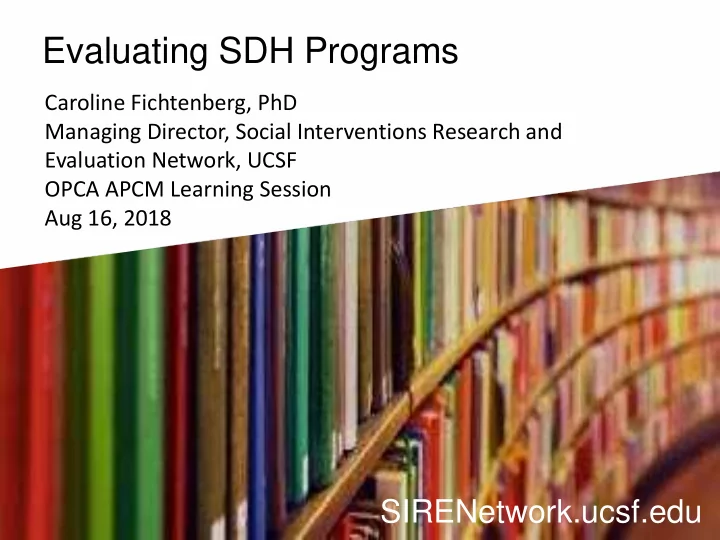

Evaluating SDH Programs Caroline Fichtenberg, PhD Managing Director, Social Interventions Research and Evaluation Network, UCSF OPCA APCM Learning Session Aug 16, 2018 SIRENetwork.ucsf.edu
Reduce Reduce Improve Reduce Social Costs Health Utilizations Needs siren
“Social needs care” Screen for unmet social needs Refer to Refer to Refer to Provide external internal internal navigation, resources, e.g. resources, e.g. resources, e.g. e.g. with food bank, food food CHW, SW, benefits pharmacy, pharmacy, patient assistance, medical-legal medical-legal navigator, etc. etc. partnership partnership siren
Does this work? siren
Early-Adopters Researchers siren
Growth in SDH publications, 2000-2016 1000 SDH 800 Number of articles 600 SDH + Health care 400 200 0 2000 2001 2002 2003 2004 2005 2006 2007 2008 2009 2010 2011 2012 2013 2014 2015 2016
Growth in SDH evaluation publications 1000 Clinical SDH intervention evaluations 800 SDH Number of articles SDH + Health care 600 400 200 11 8 9 5 5 6 4 3 3 4 1 2 0 2 1 1 1 0 2000 2001 2002 2003 2004 2005 2006 2007 2008 2009 2010 2011 2012 2013 2014 2015 2016 Gottlieb LM, Wing H, Adler NE. A systematic review of interventions on patients' social and economic needs. Am J Prev Med. 2017
Barriers to Evaluating Social Needs Interventions • Multicomponent interventions • Multiple impacts and causal pathways • Time horizon Gottlieb L, Ackerman S, Wing H, Adler N. Evaluation activities and influences at the intersection of medical and social services. J Health Care Poor Underserved. 2017;28(3):931- 951.
Barriers to Evaluating Social Needs Interventions • Regression to the mean • Lack of control groups • Limited evaluation capacity and resources in intervention settings Gottlieb L, Ackerman S, Wing H, Adler N. Evaluation activities and influences at the intersection of medical and social services. J Health Care Poor Underserved. 2017;28(3):931- 951.
Measuring Impact (incl. ROI) Data + Design siren
Measuring Impact (incl. ROI) Data + Design - What services - Control group!! - Time horizon patients received - Relevant outcomes - Potential confounders siren
Data for ROI: Think outside the $ box $ siren
Reduce Reduce Improve Reduce Social Costs Health Utilizations Needs siren
Reduce Health Inequities Reduce Improve Social Health Needs Reduce Reduce Costs Utilizations siren
Reduce Reduce Improve Reduce Social Costs Health Utilizations Needs Call-center based social services referral program: Expenditures $2,443 (10%) lower if social needs met. Pruitt Z et al. Popul Health Manag. 2018. Epub ahead of print.
Reduce Reduce Improve Reduce Social Costs Health Utilizations Needs Medically tailored meal program: - Fewer emergency department visits - Fewer inpatient admissions - Lower medical spending Non-tailored meals: - Fewer emergency department visits - Lower medical spending Berkowitz SA et al. Health Aff (Millwood). 2018;37(4):535-542.
Reduce Health Inequities Reduce Improve Social Health Needs Reduce Reduce Costs Utilizations Systematically screening and referring for social needs services during well child care increased families’ receipt of community resources. Garg A et al. Pediatrics. 2015;135(2):e296-304.
Reduce Health Inequities Reduce Improve Social Health Needs Reduce Reduce Costs Utilizations Referring to services to address unmet basic resource needs in primary care was associated with modest improvements in blood pressure and lipid levels. Berkowitz SA et al. JAMA Intern Med 2016;177(2):244-252
Reduce Health Inequities Reduce Improve Social Health Needs Reduce Reduce Costs Utilizations In-person resource navigation for pediatric patients in primary care and urgent care settings reduced reported social and economic needs and improved caregiver reported child health status 4 months later. Gottlieb LM et al. JAMA Pediatr. 2016;170(11):e162521.
Reduce Health Inequities Reduce Improve Social Health Needs Reduce Reduce Costs Utilizations Improve Experience of Care Improve Quality of Care Reduce Staff Burnout
Reduce Health Inequities Reduce Improve Social Health Needs Reduce Reduce Costs Utilizations Improve Experience of Care Primary care: Knowing the Improve patient had a social need Quality of changed care delivery in 23% Care of patients and helped improve interactions with and Reduce Staff knowledge of the patient in Burnout 53%. Tong ST et al. JABFM 2018;31(3):351-363.
Reduce Health Inequities Reduce Improve Social Health Needs Reduce Reduce Costs Utilizations Improve Experience of Care Higher perceived Improve organizational capacity to Quality of address SDH in the primary Care care setting significantly associated with lower Reduce Staff provider burnout. Burnout Olayiwola JN et al. JHCPU 2018;29(1):415-429.
siren
siren http://sirenetwork.ucsf.edu
Time
Questions? Contact: caroline.fichtenberg@ucsf.edu Website: http://sirenetwork.ucsf.edu Twitter: @SIREN_UCSF siren
Recommend
More recommend